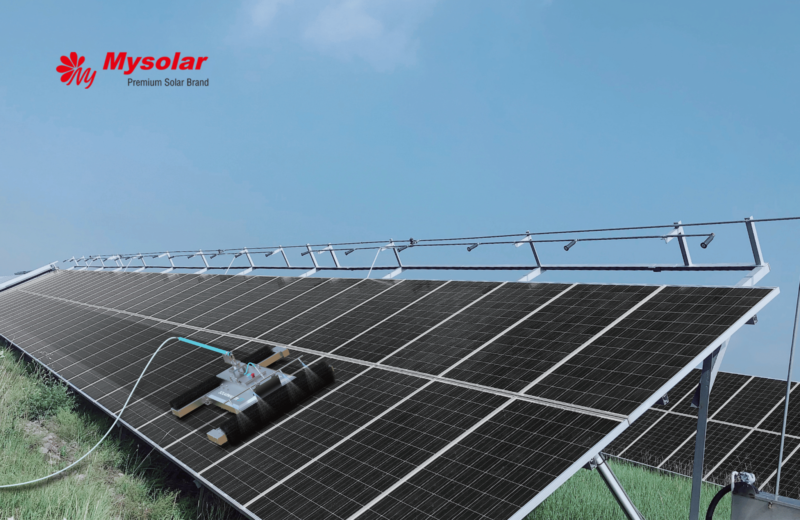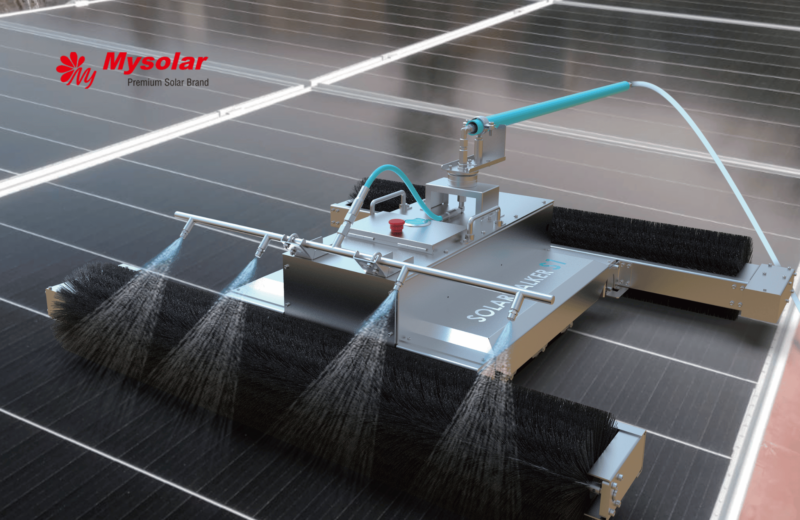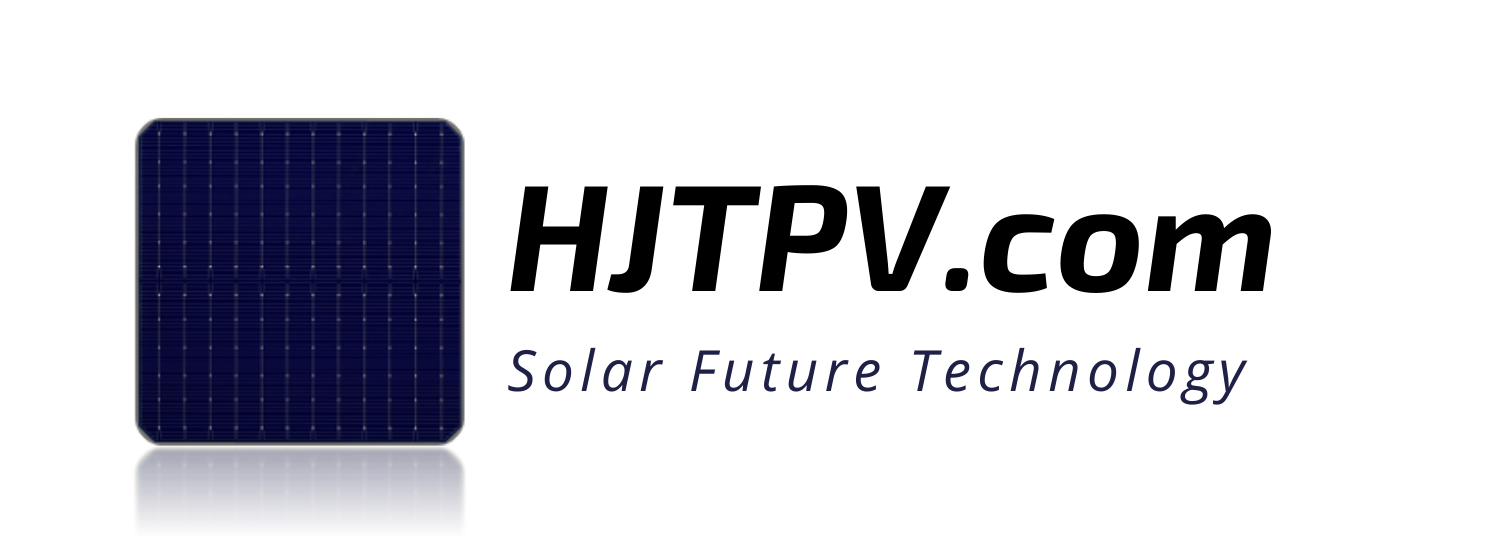
PV Cleaning Robot what is it?
A solar panel cleaning robot is an autonomous or semi-autonomous machine designed to clean solar panels efficiently and effectively. The purpose of such a robot is to remove dust, dirt, debris, and other contaminants from the surface of solar panels, thereby optimizing their performance and energy output.
Here are some key features and considerations for a solar panel cleaning robot:
-
Autonomous navigation: The robot should be equipped with sensors and algorithms to navigate safely and efficiently on the solar panel array without causing damage.
-
Cleaning mechanism: The robot may use various cleaning methods, such as brushes, microfiber pads, or water jets, to remove dirt and grime from the solar panels’ surface.
-
Energy source: The cleaning robot should ideally have its own power source, such as a rechargeable battery, so it can operate independently without relying on the solar panels it is cleaning.
-
Safety mechanisms: To prevent accidents or damage, the robot should have safety features like obstacle detection, anti-fall protection, and fail-safe systems.
-
Weather adaptability: The robot should be designed to operate effectively in various weather conditions, such as rain, snow, or extreme temperatures.
-
Maintenance and durability: The robot should be built with durable materials capable of withstanding the rigors of regular cleaning operations. It should also have a user-friendly design for easy maintenance and repair.
-
Monitoring and control: The robot can be equipped with sensors or cameras to monitor the cleanliness and condition of the solar panels. It can also have a remote control or connectivity features for monitoring and controlling its operation.
-
Cost-effectiveness: The robot should provide a cost-effective solution by reducing the manual labor and time required for cleaning solar panels, as well as potentially increasing the overall energy production of the panels.
It’s worth noting that there are several companies and research institutions working on developing solar panel cleaning robots, each with their own unique designs and features. The specific capabilities and functionality of a solar panel cleaning robot may vary depending on the manufacturer or the specific requirements of the installation.

Solar panel cleaning advantages
Cleaning solar panels regularly offers several advantages:
Increased energy production: Dust, dirt, and debris accumulation on solar panels can reduce their efficiency and hinder sunlight absorption. Cleaning the panels removes these obstructions, allowing them to capture more sunlight and generate more electricity. Studies have shown that cleaning solar panels can increase their energy output by 5% to 30%.
Improved return on investment (ROI): By maximizing energy production, cleaning solar panels helps ensure a higher return on investment. The additional electricity generated from clean panels can result in more savings on electricity bills or increased revenue from selling excess power back to the grid.
Long-term system performance: Over time, dirt and debris build-up on solar panels can lead to permanent damage if left unattended. Cleaning them regularly helps maintain the panels’ performance and extends their lifespan. By protecting the panels from potential damage, cleaning contributes to the long-term reliability of the solar energy system.
Environmental benefits: Solar energy is a clean and renewable energy source. By keeping solar panels clean and operating at optimal efficiency, the overall environmental impact of solar energy is enhanced. Cleaning reduces the need for additional fossil fuel-based electricity generation, resulting in lower greenhouse gas emissions and a smaller carbon footprint.
Maintenance detection: Cleaning solar panels allows for close inspection of the panels’ condition. It helps identify any potential maintenance issues, such as loose connections, cracked panels, or faulty wiring. Early detection enables timely repairs, preventing further damage and minimizing downtime.
Cost savings: Regular cleaning can reduce the need for costly maintenance and repairs caused by neglected or damaged solar panels. By investing in cleaning, you can potentially save money by avoiding expensive fixes or panel replacements in the future.
Aesthetics and property value: Clean solar panels enhance the visual appeal of a property. Whether it’s a residential or commercial installation, well-maintained solar panels contribute to a clean and modern appearance. Additionally, solar panels are an attractive feature for potential buyers or tenants, increasing the property value and marketability.
It’s important to note that the frequency of cleaning required depends on factors such as the location, climate, and local environmental conditions. Consulting with solar panel manufacturers or professionals can provide specific recommendations for cleaning schedules and techniques tailored to your installation.

Solar cleaning robot for solar farms
A solar cleaning robot designed for solar farms can provide several benefits in terms of efficiency and cost-effectiveness. Here are some advantages of using a solar cleaning robot for large-scale solar farms:
Time and labor savings: Solar farms typically consist of a vast number of solar panels, making manual cleaning a time-consuming and labor-intensive task. A solar cleaning robot can automate the cleaning process, significantly reducing the time and effort required by human workers. It can clean multiple panels simultaneously and operate autonomously, allowing workers to focus on other important tasks.
Increased cleaning accuracy and consistency: The precise movements and cleaning patterns of a robot ensure consistent and thorough cleaning of each solar panel. Unlike manual cleaning, which can vary in quality depending on the worker’s technique, a robot follows programmed paths to ensure uniform cleaning across the entire solar farm. This results in optimized energy production and improved overall system performance.
Enhanced safety: Cleaning solar panels on large-scale solar farms can involve working at heights or in challenging terrain. By utilizing a solar cleaning robot, the need for workers to physically access the panels is reduced, minimizing the risk of accidents or injuries. The robot can navigate difficult terrain and handle cleaning tasks with built-in safety features.
Cost-effective maintenance: A solar cleaning robot can help reduce maintenance costs associated with manual cleaning methods. By automating the cleaning process, it eliminates the need for hiring additional cleaning crews or outsourcing the task to third-party cleaning services. The upfront investment in a solar cleaning robot can be offset by long-term savings in labor and maintenance expenses.
Improved energy production: Solar panels that are regularly cleaned by a robot maintain optimal efficiency and generate more electricity. The removal of dust, dirt, and debris ensures maximum sunlight absorption and prevents shading or hotspots on the panels. This leads to increased energy production, higher energy yields, and improved financial returns for the solar farm.
Remote monitoring and control: Many solar cleaning robots come equipped with remote monitoring and control capabilities. This allows operators or maintenance personnel to remotely monitor the robot’s performance, schedule cleaning cycles, and receive real-time data on the cleanliness and condition of the solar panels. Remote control features enable efficient management and troubleshooting, reducing downtime and maximizing the robot’s productivity.
Adaptability to various terrains and weather conditions: Solar cleaning robots are designed to operate in different types of terrains found in solar farms, including uneven surfaces or slopes. They are also built to withstand various weather conditions, such as rain, heat, and cold temperatures. This adaptability ensures consistent cleaning performance regardless of the environmental challenges.
Overall, utilizing a solar cleaning robot for solar farms streamlines the cleaning process, improves energy production, and reduces operational costs. By automating the cleaning tasks, solar farm operators can maximize the performance and longevity of their solar panels while optimizing the return on investment.

Solar cleaner robot with HJT solar panels perfect combination for power output
The combination of a solar cleaning robot with HJT (Heterojunction) solar panels can indeed be advantageous for power output. Here’s why:
Enhanced efficiency: HJT solar panels are known for their high efficiency, as they combine the advantages of traditional crystalline silicon solar cells with thin-film technology. By incorporating layers of amorphous silicon on top of the crystalline silicon cells, HJT panels can achieve higher conversion efficiencies. When combined with regular cleaning by a solar cleaning robot, the panels can maintain optimal efficiency levels by removing any dust, dirt, or debris that may hinder sunlight absorption. This synergy between HJT panels and a cleaning robot ensures maximum power output.
Improved performance in low light conditions: HJT solar panels are also known for their excellent performance in low light conditions, such as cloudy or overcast weather. They have a lower temperature coefficient and can generate electricity even when sunlight intensity is relatively low. Regular cleaning of HJT panels ensures that they can capture as much available light as possible, maximizing their performance in all lighting conditions.
Reduction of hotspots: HJT solar panels are less susceptible to hotspots compared to traditional crystalline silicon panels. Hotspots occur when certain areas of a solar panel are shaded or damaged, leading to localized heating and reduced efficiency. By keeping HJT panels clean, the solar cleaning robot helps prevent shading and ensures uniform sunlight distribution across the panel surface, minimizing the risk of hotspots and optimizing power output.
Long-term reliability: Both HJT solar panels and a solar cleaning robot contribute to the long-term reliability of a solar energy system. HJT panels are known for their durability and long lifespan. Regular cleaning removes contaminants that could potentially cause damage or degrade the panel’s performance over time. By maintaining the cleanliness of HJT panels, the solar cleaning robot helps prolong their lifespan and ensures consistent power output throughout the system’s operational life.
Cost-effectiveness: HJT solar panels are a higher-end technology with higher upfront costs compared to conventional panels. Maximizing their power output through regular cleaning can help maximize the return on investment. By preventing performance degradation and maintaining optimal efficiency, the combination of a solar cleaning robot and HJT panels can contribute to long-term cost savings and increased financial returns.
It’s important to note that regular cleaning is beneficial for any type of solar panel, regardless of the technology used. However, the synergy between HJT panels and a solar cleaning robot can help harness the full potential of HJT technology by ensuring optimal cleanliness, performance, and power output.
Are the PV Robot Cleaner is Worth to use ?
Even the best technologically advanced solar panels, such as HJT 700W, can’t work with full power when dirty. This is why increasing the full potential of solar farms, business and industrial installations is worth using clean robots. Even a few percent of more power in the yearly time frame and a huge scale of MW can generate additional ROI. This is why reasonable is to choose manufacturer modules eg. HJT 700W and at the same time robot cleaner as is Mysolar.

